steering CADILLAC DEVILLE 1995 7.G User Guide
[x] Cancel search | Manufacturer: CADILLAC, Model Year: 1995, Model line: DEVILLE, Model: CADILLAC DEVILLE 1995 7.GPages: 403, PDF Size: 20.69 MB
Page 203 of 403
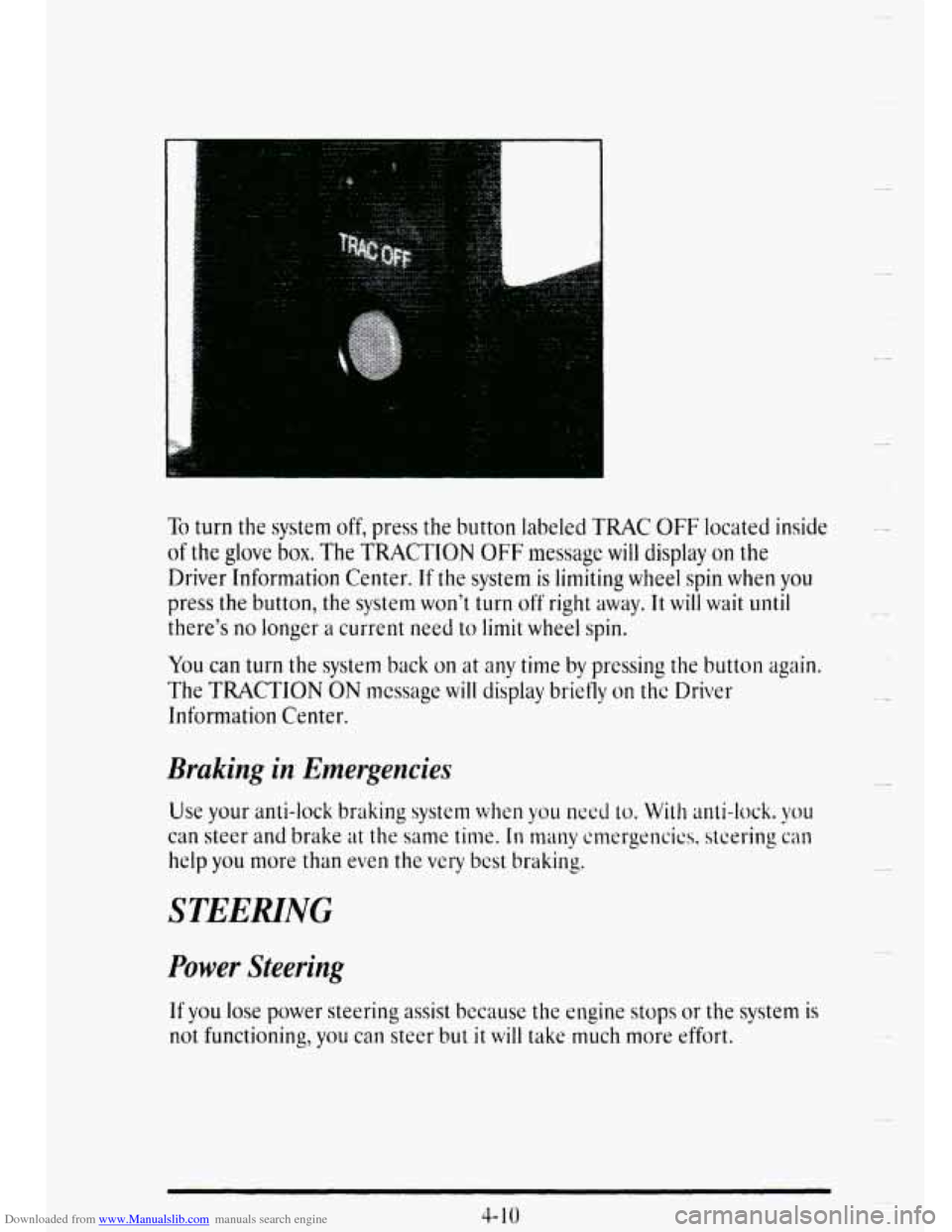
Downloaded from www.Manualslib.com manuals search engine ..... .. ..
..
. . . . . . . .. . .. .. .
To turn the system off, press the button labeled TRAC OFF located inside
of
the glove box. The TRACTION OFF message will display on the
Driver Information Center.
If the system is limiting wheel spin when you
press the button, the system won’t iurn off right away. It will wait until
there’s no longer a current need to limit wheel spin.
You can turn the system back on at any time by pressing the button again.
The TRACTION ON nmsage will display briefly on thc Driver
Information Center.
L
Braking in Emergencies
Use your anti-lock braking system when you need to. With anti-lock. you
can steer and brake at the same time. In nlanv cmergencics. steering can
help you more than even the very best braking.
STEEMNG
Power Steering
If you lose power steering assist because the engine stops or the system is
not functioning, you can steer but it will take much more effort.
4- lo
c
-
Page 204 of 403
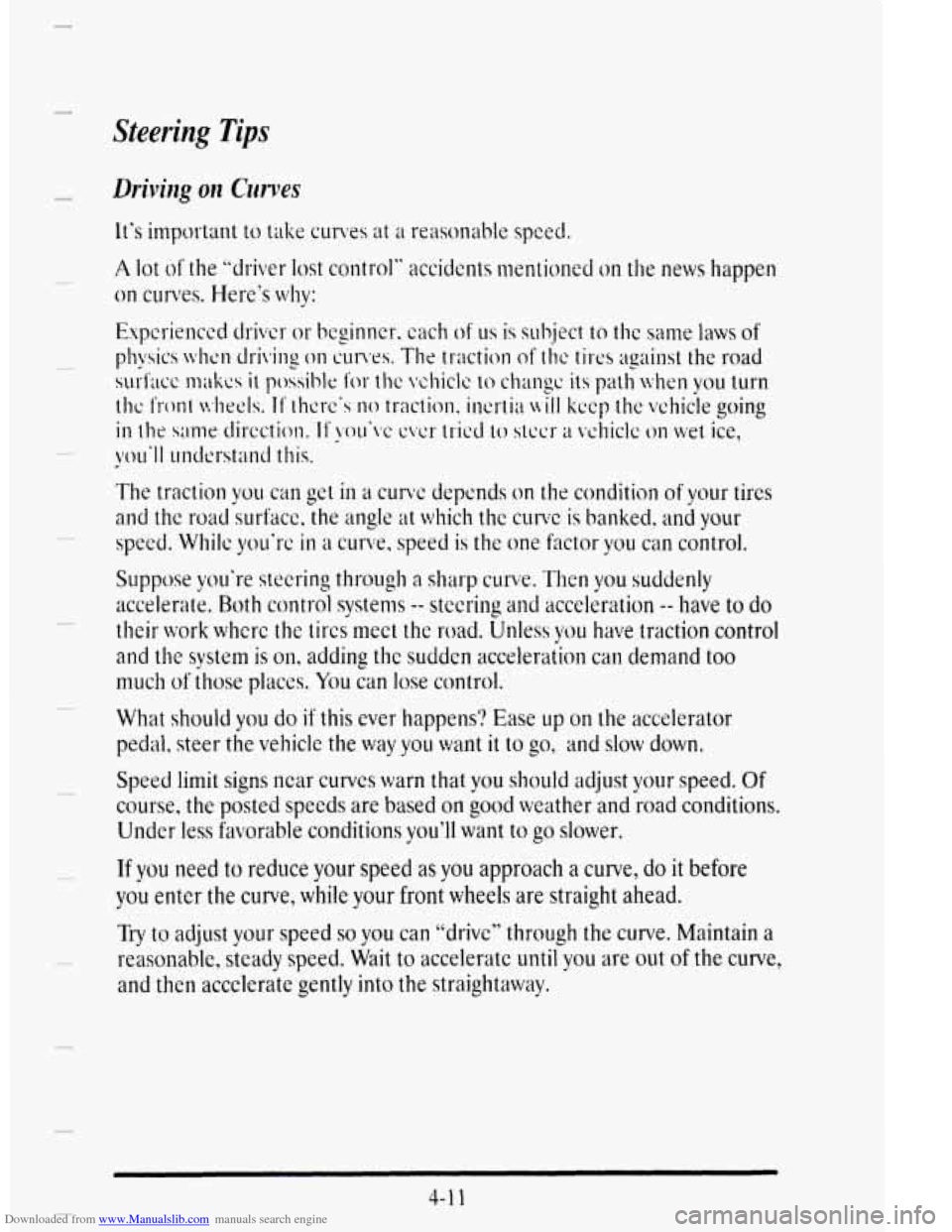
Downloaded from www.Manualslib.com manuals search engine 3
Steering Tips
The traction vou can get in a CUI-VC depcnds on the condition of your tires
and the roaddsurfacc, the angle at which thc cun~ is banked, and your
speed. Whilc
you'rc in a curve, speed is the one factor you can control.
Suppose you're steering
through c a sharp curve. Then you suddenly
accelerate.
Both control systems -- stccring and acceleration -- have to do
their work where the tircs meet the road. Unless you have traction control
and the system is on, adding the sudden acceleration can demand too
muck of those places. You can lose control.
What should you
do if this ever happens'? Ease up on the accelerator
pedal, steer the vehicle the way you want it to go, and slow down.
Speed limit signs near curves warn that you should adjust your speed. Of
course, the posted speeds are based on good weather and road conditions.
Under less favorable conditions you'll want to go slower.
If you need to reduce your speed as you approach a curve, do it before
you enter the curve, while your front wheels are straight ahead.
Try to adjust your speed so you can "drive" through the curve. Maintain a
reasonable, steady speed. Wait to accelerate until you are out of the curve,
and then accelerate gently into the straightaway.
4-1 1
Page 205 of 403
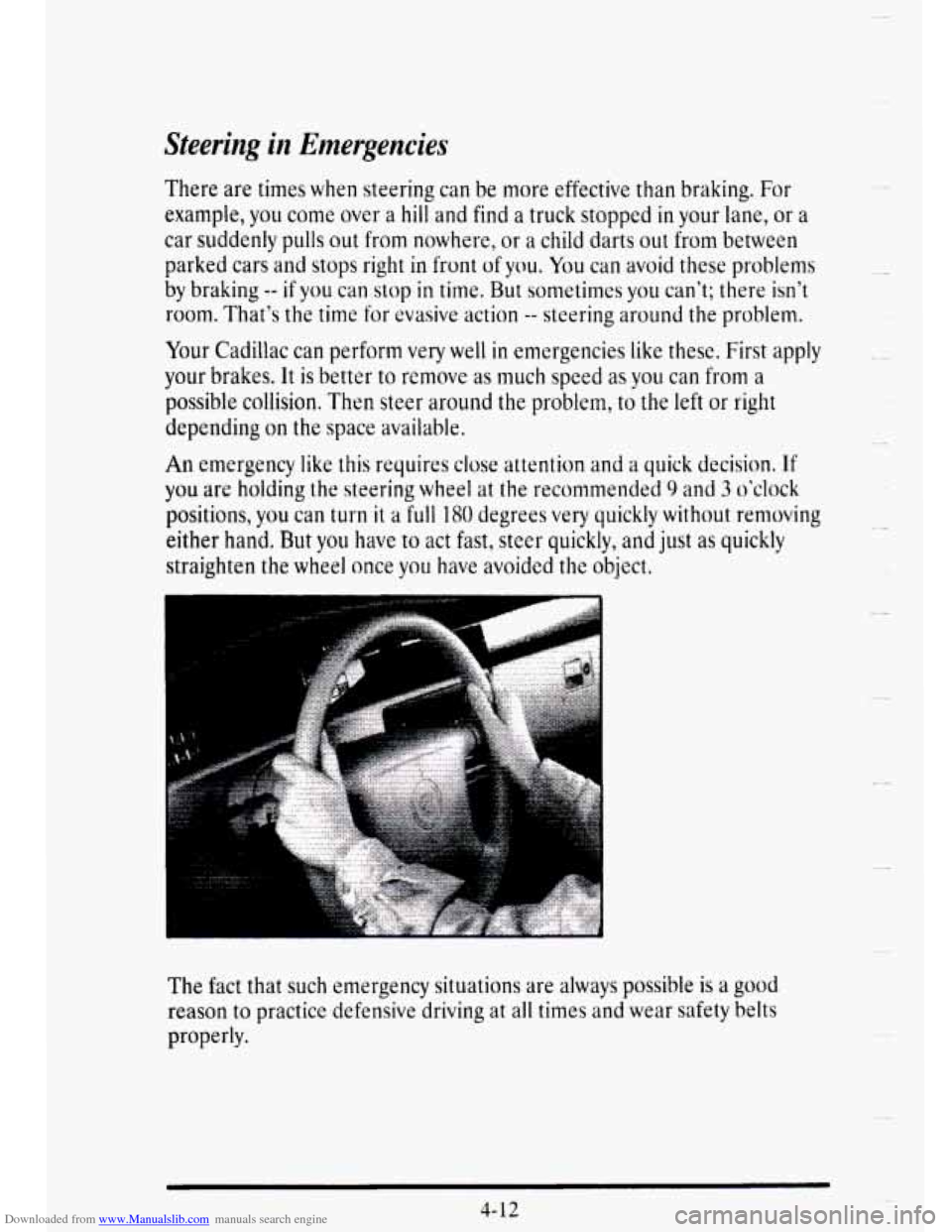
Downloaded from www.Manualslib.com manuals search engine Steering in Emergencies
There are times when steering can be more effective than braking. For
example,
you come over a hill and find a truck stopped in your lane, or a
car suddenly pulls out from nowhere, or a child darts out from between
parked cars and stops right
in front of you. You can avoid these problems
by braking -- if you can stop in time. But sometimes you can’t; there isn’t
room. That’s the time for evasive action -- steering around the problem.
Your Cadillac can perform very well in emergencies like these. First apply
your brakes. It is better to remove as much speed as you can from a
possible
collision. Then steer around the problem, td the left or right
depending on the space available.
An emergency like this requires close attention and a quick decision. If
you are holding the steering wheel at the recommended 9 and 3 o’clock
positions, you can turn
it a full 180 degrees very quickly without renmving
either hand.
But you have to act fast, steer quickly, and just as quickly
straighten the wheel once
you have avoided the object,
-4 c
c-
.^
The fact that such emergency situations are always possible is a good
reason to practice defensive driving at
all times and wear safety belts
properly.
4-12
Page 206 of 403
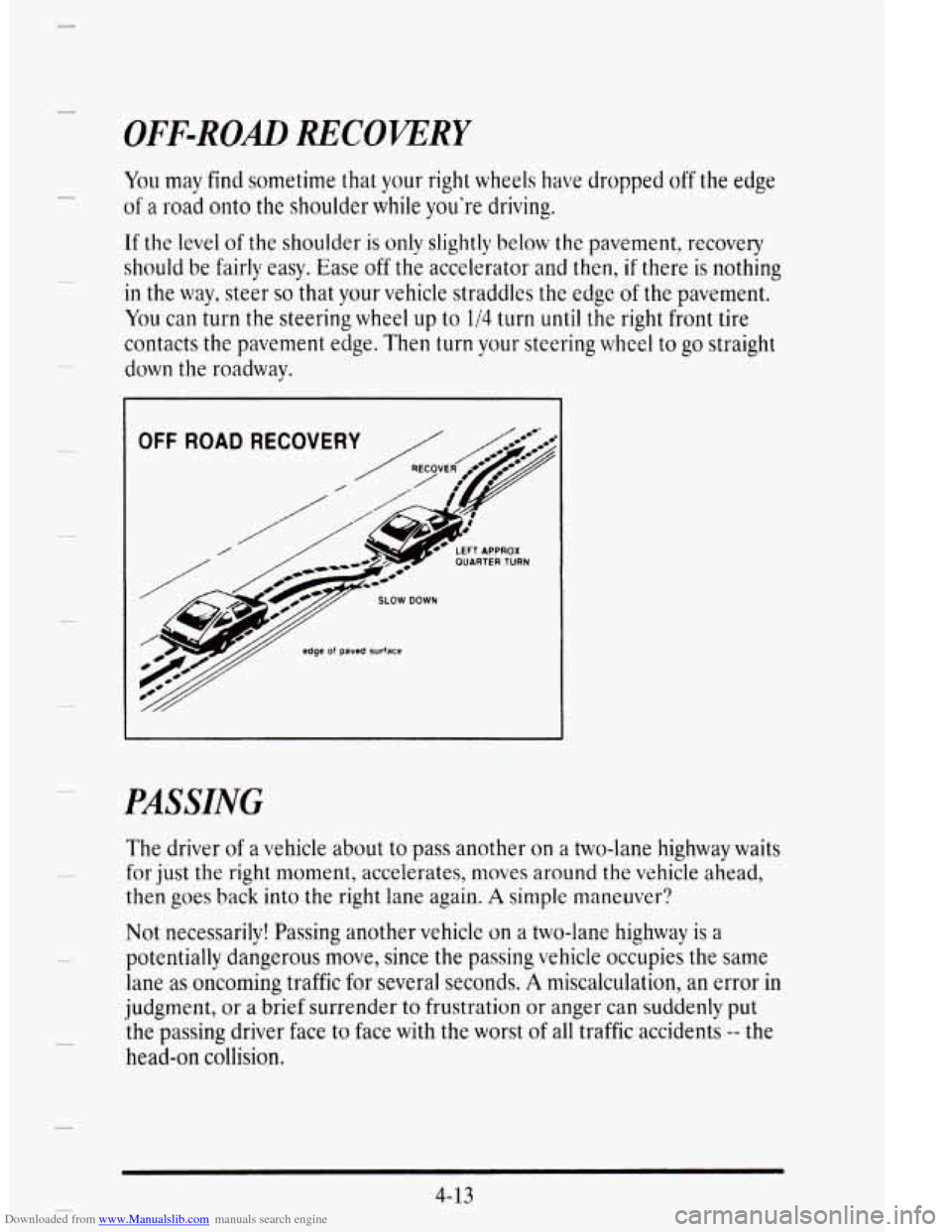
Downloaded from www.Manualslib.com manuals search engine OFF-ROAD RECOVERY
You mav find sometime that your right wheels have dropped off the edge
of a rmd onto the shoulder while you’re driving.
If the level of the shoulder is only slightly below the pave.ment, recovery
should
be fairly easy. Ease off the accelerator and then, if there is nothing
in the way, steer so that vour vehicle straddles the edge of the pavement.
You can turn the steering wheel up to 1/4 turn until the right front tire
contacts the pavement edge. Then turn your steering wheel to go straight
down the roadway.
PASSING
The driver of a vehicle about to pass another on a two-lane highway waits
for
just the right moment, accelerates, moves around the vehicle ahead,
then goes back into the right lane again. A simple maneuver?
Not necessarily! Passing another vehicle on a two-lane highway is a
potentially dangerous move, since the passing vehicle occupies the same
lane
as oncoming traffic for several seconds. A miscalculation, an error in
judgment, or a brief surrender to frustration or anger can suddenly put
the passing driver face to face with the worst of all traffic accidents -- the
head-on collision.
4-13
Page 208 of 403
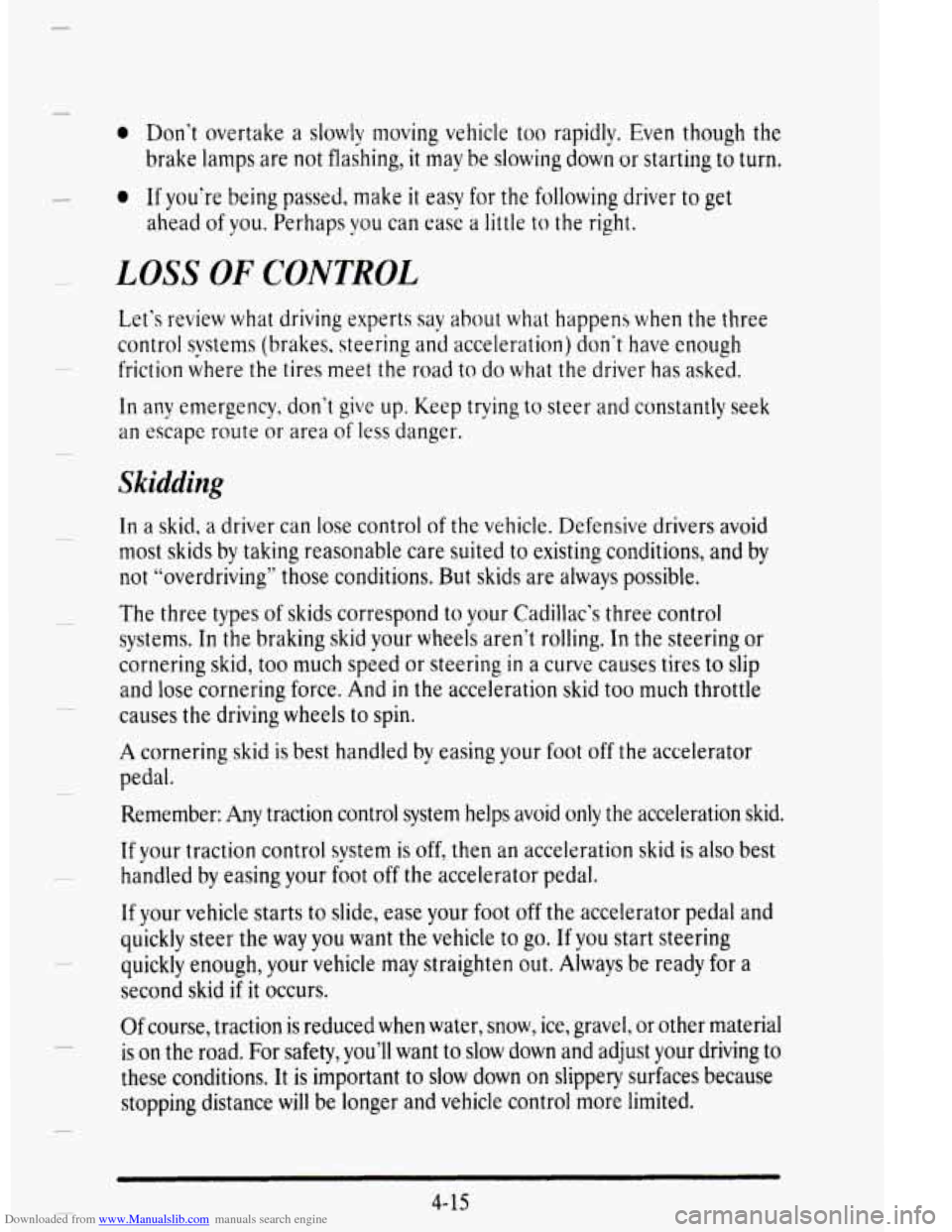
Downloaded from www.Manualslib.com manuals search engine 0 Don't overtake a slowly moving vehicle too rapidly. Even though the
brake lamps are not flashing,
it may be slowing down or starting to turn,
0 If you're being passed, make it easv for the following driver to get
ahead
of you. Perhaps you can easi a little to the right.
LOSS OF CONTROL
Let's review what driving experts sav about what happens when the three
control svstems (brakes, steering an> acceleration)
don't have enough
friction where the tires meet the road to do what the driver has asked.
In any emergency, don't give up. Keep trying to steer and constantly seek
an escape route or area of less danger.
In a skid, a driver can lose control of the vehicle. Defensive drivers avoid
most skids
by taking reasonable care suited to existing conditions, and by
not "overdriving" those conditions.
But skids are always possible.
The three types of skids correspond to your Cadillac's three control
systems.
In the braking skid your wheels aren't rolling. In the steering or
cornering skid, too much speed or steering
in a curve causes tires to slip
and lose cornering force. And
in the acceleration skid too much throttle
causes
the driving wheels to spin.
A cornering skid is best handled by easing your foot off the accelerator
pedal.
Remember: Any traction control system helps avoid only the acceleration skid.
If your traction control system
is off? then an acceleration skid is also best
handled by easing your
foot off the accelerator pedal.
If your vehicle starts to slide, ease your foot off the accelerator pedal and
quickly steer
the way you want the vehicle to go. If you start steering
quickly enough, your vehicle may straighten out. Always be ready for a
second skid
if it occurs.
Of course, traction is reduced when water, snow, ice, gravel, or other material
is on the road. For safety, you'll want to slow down and adjust your driving to
these conditions. It is important to
slow down on slippery surfaces because
stopping distance will be longer and vehicle control more limited.
4-15
Page 209 of 403

Downloaded from www.Manualslib.com manuals search engine While driving on a surface with reduced traction, try Vour best to avoid
sudden steering, acceleration?
or braking (including engine braking by
shifting to a lower gear). Any sudden changes could cause the tires to
slide. You may not realize the surfdce is slippery until your vehicle is
skidding.
Leain to recognize warning clues -- such as enough water, ice or
packed snow on the road to make a “mirrored surface” -- and slow down
when
you have any doubt.
Remember:
Any anti-lock brake system (ABS) helps avoid only the
braking L. skid.
DRIVING AT NIGHT
Night driving is more dangerous than day driving. One reason is that some
drivers are likely to be impaired -- by alcohol or drugs, with night vision
problems,
or by fatigue.
Here are some tips on night driving.
0 Drive defensively.
0 Don’t drink and drive.
4-16
.I
Page 232 of 403
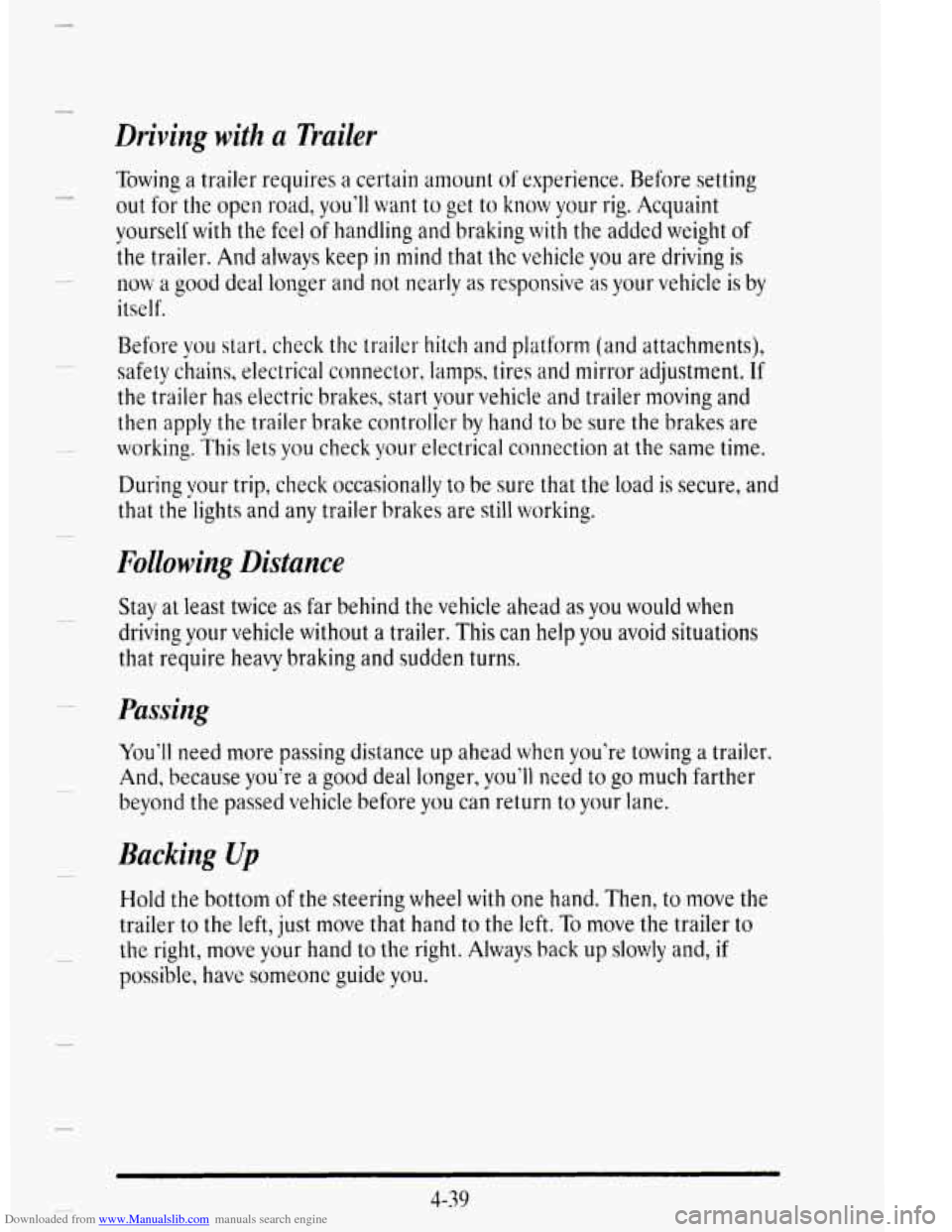
Downloaded from www.Manualslib.com manuals search engine Driving with a Trailer
Towing a trailer requires a certain amount of experience. Before setting
out for the open road, you’ll want to get to know your rig. Acquaint
yourself
with the feel of Ilandling and braking with the added weight of
the trailer. And always keep in mind that thc vehicle you are driving is
now a good deal longer and not nearly as responsivs as your vehicle is by
itself.
Before you start, check thc trailer hitch
and platform (and attachments),
safety chains, electrical connector, lamps, tires
and mirror adjustment. If
the trailer has electric brakes, start your vehicle and trailer moving and
then apply the trailer brake controlier by hand
to be sure the brakes are
working.
This lets you check your electrical connection at the same time.
During \Tour trip, check occasionally to
be sure that the load is secure, and
that the’lights and any trailer brakes are still working.
Following Distance
Stay at least twice as far behind the vehicle ahead as you would when
driving your vehicle without a trailer. This can help
you avoid situations
that require heavy braking and sudden turns.
Passing
You’ll need more passing distance up ahead when you’re towing a trailer.
And, because you‘re a good deal longer,
you’ll need to go much farther
beyond
the passed vehicle before you can return to your lane.
Bucking Up
Hold the bottom of the steering wheel with one hand. Then, to move the
trailer
to the left, just move that hand to the left. To move the trailer to
the right, move your hand to the right. Always back up slowly and, if
possible, havc someone guide you.
4-39
Page 246 of 403
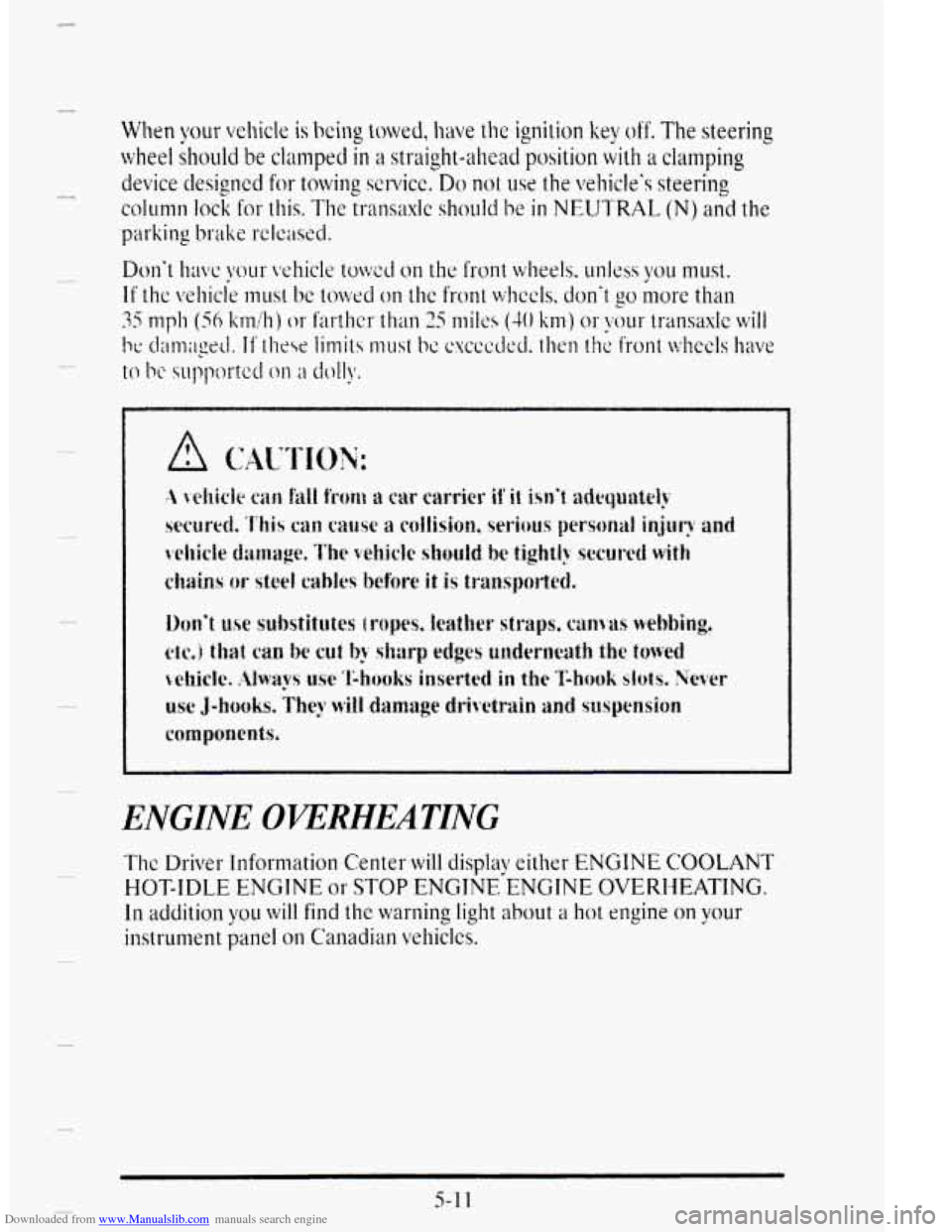
Downloaded from www.Manualslib.com manuals search engine When your vehicle is being towed, have the ignition key off. The steering
wheel should be clamped in a straight-ahead position with a clamping
device designed for towing selvicc. Do not use the whicle's steering
colunln lock for this. The trallsaxlc should he in NEUTRAL (N) and the
parking hrake relc;lsd.
ENGINE OVERHEATING
c
TIIC Driver Information Center will displav either ENGINE COOL.ANT
HOT-IDLE ENGINE 01 STOP ENGINEdENGINE OVERHEATING.
In addition you will find the warning light about a hot engine on your
instrument panel on Canadian vehiclcs.
Page 269 of 403

Downloaded from www.Manualslib.com manuals search engine IF Y0UX.E STUCK: IN SAND, MUD, ICE OR
SNOW
What you don't want to do when your vehicle is stuck is to spin your
wheels too fast. The method known as .*rocking" can help you get out
when you're stuck, but you must use caution.
u
NOTICE:
Spinning your wheels can destroy parts of your vehicle as well
as the tires. If you spin the wheels too Fast while shifting your
transaxle back and forth, you can destroy your transaxle.
For information about using tire chains on your vehicle, see "Tire Chains"
in the Index.
Rocking your vehicle to get it out:
First, turn your steering wheel left and right. That will clear the area
around your
front wheels. You should turn your traction control system
off. (See "Traction Control System" in the Index.) Then shift back and
forth between REVERSE (R) and a forward gear, spinning the wheels as
little as possible. Release the accelerator pedal while you shift, and press
lightly on the accelerator pedal when the transaxle is in gear. if that
doesn't get you out after a few tries, you may need to be towed out. If you
do need to be towed aut, see '*Towing Your Vehicle" in the Index.
5-34
-.
Page 292 of 403

Downloaded from www.Manualslib.com manuals search engine P
I!
c
6
THERMOSTAT
Engine L. coolant temperature is controlled by a thermostat in the engine
coolant system. The thermostat stops the
flow of coolant through the
radiator until the coolant reaches
a preset temperature.
If vour thermostat needs to be replaced an AC'"' thermostat is
re&m-nended.
-
POWER STEERING FLUID
P
c
6-23